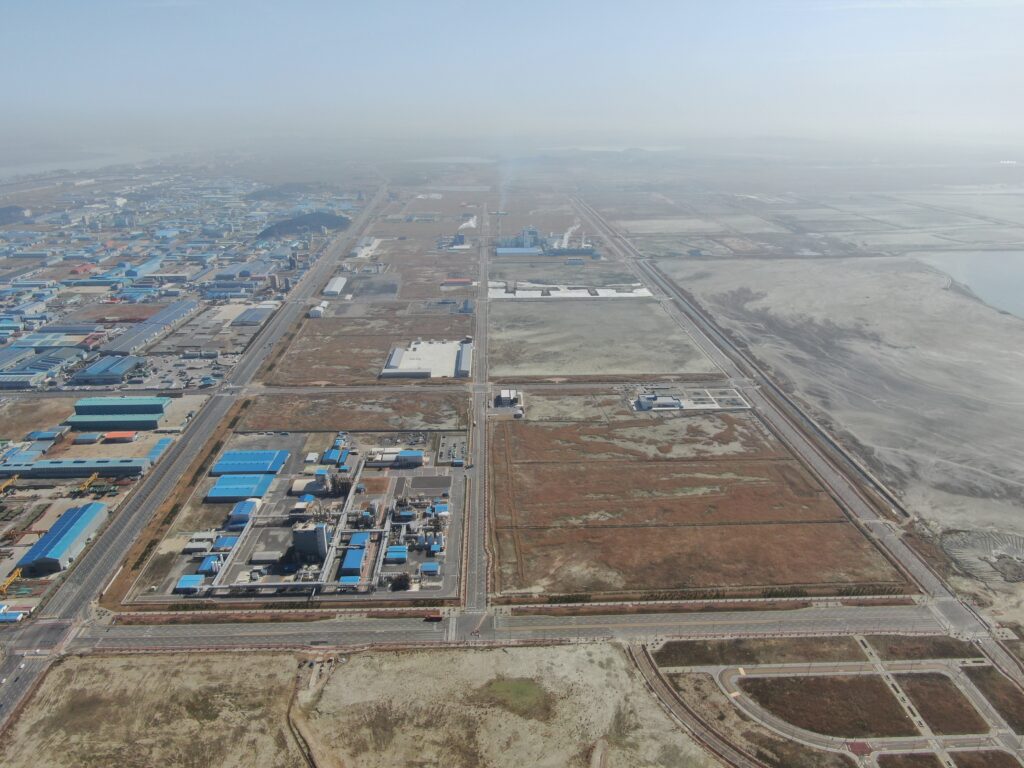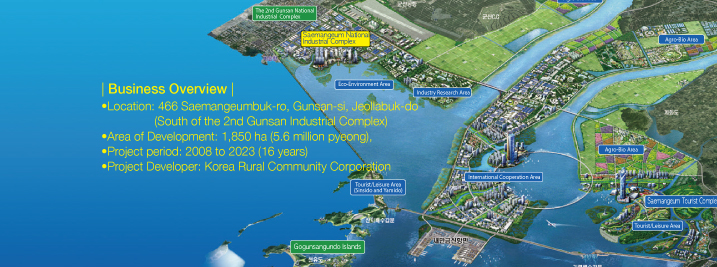A 33.9 km-long sea dyke is seen at the Saemangeum land reclamation project area in the western coastal area of the Korean Peninsula near Gunsan, Gimjae and the Buan areas of North Jeolla Province. The Saemangeum Seawall runs between two headlands, and separates the Yellow Sea and the former Saemangeum estuary. The seawall has been completed, but an enormous land reclamation project in the inside of the seawall is still underway.
The Saemangeum development project goes back 34 years ever since former President Tae-woo Roh’s pledge in 1987. Construction on the dyke began in 1991, built by the Ministry of Food, Agriculture, Forestry and Fisheries and the Korea Rural Community Corporation, and the world’s longest man-made tide embankment was officially completed on 27 April 2010. The newly created area is a total of 40,900ha (409㎢) of a reclaimed area including 29,100ha of land and 11,800ha of freshwater, which is equivalent to two-thirds of Seoul and four times as big as Paris.

The estuarine tidal flats are considered important, but are also within a tension field between economy and nature and between preservation and development. The construction of the Saemangeum Seawall caused controversy from the moment it was announced as environmental activists protested against it and there were clashes between different political interest groups. Initially, 180 billion dollars were allocated, but it was only about 5 billion committed indeed. After years of legal wrangling and changes in how to utilize the land, the Saemangeum, once called a “wasteland”, is being turned into new future spaces for hope.

The Saemangeum National Industrial Complex (hereafter, Saemangeum NIC), a 2.2 billion dollar project operated by Korea Rural Community Corporation (hereafter, KRC), covers 1,850ha of Saemangeum District. It is only 4.5% of the entire project area and will be developed into areas devoted to a green energy industrial complex, an cutting-edge industry complex, an eco-friendly agricultural complex, and tourism and multi-use zones. After the Moon administration declared ambitious plans to create “the world’s largest” renewable energy cluster in Saemangeum, the Saemangeum NIC became a magnet for new investment. The Saemangeum NIC can be a cornerstone for ‘Renewable Energy 100% (RE 100)’ initiative as the district is designed to utilize only renewable energy resources including solar photovoltaic power generation, offshore wind energy, and green hydrogen energy.
As the area is within three hours away to travel 60 cities with a population of more than 1 million by airplane, Saemangeum can be a strategic hub located at the center of the Yellow Sea region with comfortable access to China, Japan, and Eurasia. It is the most attractive place for both global companies that want to enter China and Chinese companies that want to explore new markets such as the U.S. and the European Union. The Saemangeum-Gunsan Free Economic Zone (SGFEZ) has been designated as an area for Korea-China economic cooperation, offering the best place for investment without any hassle or regulations. It’s the first transnational economic cooperation special district in Korea.
The KRC has put considerable effort into attracting private sector finance into the project by establishing diverse infrastructures. New installation or expansion of the highway is undergoing and a new port will be built until 2025. A preliminary feasibility study is underway to change Gunsan Airport, which was previously used with the U.S. Forces Korea, into a private international airport and to construct a railway connecting Saemangeum New Port and Gunsan Airport. When more infrastructures in preparation are established, its global strongpoint as a trade hub in Northeast Asia would be maximized.
In addition to the geopolitical strength and infrastructure, some benefits are given to companies which move into the Saemangeum NIC. Tenant companies in long-term rental land can rent a large site for up to 100 years for free. They can receive corporate and income tax benefits, such as a reduction of 100% for up to five years and a reduction of 50% for the next two years. These incentives attracted leading companies such as OCI, OCI-SE (cogeneration plant), Toray Advanced Materials Korea and Solvay Korea. As of 2021, 32 companies have signed occupancy contracts.
Saemangeum is at an important juncture in its journey. As almost half of the total Korean population lives in the northwest part of Korea covering Seoul, Incheon and Gyeonggi, Korea has suffered from uneven regional development. Jeolla Province, the south west area of the Korean peninsula, was considered remote and out-of-the-way areas. Even North Jeolla was worse than the south. There was no one left to work in the land due to a population drop while major domestic industry, including two companies that once ran their factories in Gunsan such as Hyundai Heavy Industries and GM Korea, has stayed away due to a lack of infrastructure. The fundamentals that underpinned the region’s dramatic growth and prosperity over the past five decades are not sufficient to carry us through this era of continuous disruption. New growth engine industries which will move into Saemangeum are lucrative and promising, helping the local market provide new impetus to add more jobs. Saemangeum is expected to help regional development gain momentum and give new opportunities to the region and global partners.
Kayla Hong
Asia Journal



